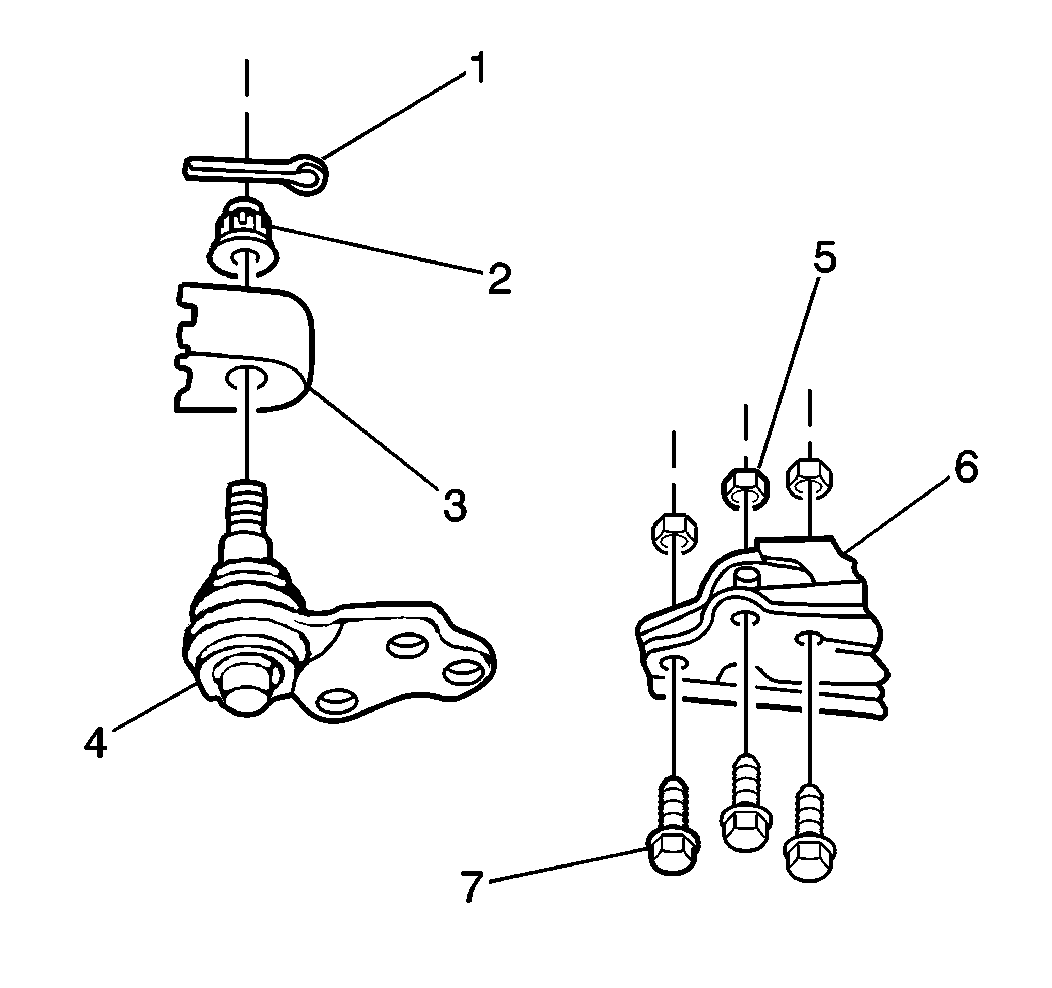Lower Control Arm Ball Joint Replacement Without V4U/B9Q
Removal Procedure
Tools Required
| • | J 35315 Ball Stud Separator |
| • | J 35551 Ball Joint Nut Wrench |
- Raise the vehicle and support the frame with jack stands. Refer to Lifting and Jacking the Vehicle in General Information.
- Remove the tire and wheel assembly. Refer to Wheel Removal in Tires and Wheels.
- Remove the Road Sensing Suspension position sensor from the lower control arm.
- Remove the ball joint from the knuckle.
- Drill out three rivets retaining ball joint starting with a 1/4 inch drill bit and finishing with a 1/2 inch drill bit.
- Remove the joint.

Installation Procedure
- Install the new ball joint (4) into the control arm (6).
- Install the ball joint to control arm bolts.
- Install the ball joint to control arm bolts.
- Install the Road Sensing Suspension position sensor to lower control arm.
- Install the tire and wheel assembly. Refer to Wheel Installation in Tires and Wheels.
- Lower the vehicle.

Notice: Use the correct fastener in the correct location. Replacement fasteners must be the correct part number for that application. Fasteners requiring replacement or fasteners requiring the use of thread locking compound or sealant are identified in the service procedure. Do not use paints, lubricants, or corrosion inhibitors on fasteners or fastener joint surfaces unless specified. These coatings affect fastener torque and joint clamping force and may damage the fastener. Use the correct tightening sequence and specifications when installing fasteners in order to avoid damage to parts and systems.
Tighten
| • | Tighten the ball joint to control arm nuts (5) to 68 N·m (50 lb ft). |
| • | Tighten the ball joint nut (2) to 10 N·m (84 lb in) using J 35551 90 degrees to torque wrench. Tighten the nut an additional 120 degrees. When tightening the nut a minimum torque of 50 N·m (37 lb ft) must be obtained. If 50 N·m (37 lb ft) is not obtained, inspect the ball joint for stripped threads. If threads are satisfactory, replace the ball joint and knuckle. If required, turn the nut up to an additional 60 degrees in order to allow for the installation of the cotter pin (1). |
Notice: Use the correct fastener in the correct location. Replacement fasteners must be the correct part number for that application. Fasteners requiring replacement or fasteners requiring the use of thread locking compound or sealant are identified in the service procedure. Do not use paints, lubricants, or corrosion inhibitors on fasteners or fastener joint surfaces unless specified. These coatings affect fastener torque and joint clamping force and may damage the fastener. Use the correct tightening sequence and specifications when installing fasteners in order to avoid damage to parts and systems.
Tighten
| • | Tighten the ball joint to control arm nuts (5) to 68 N·m (50 lb ft). |
| • | Tighten the ball joint nut (2) to 10 N·m (84 lb in) using J 35551 90 degrees to torque wrench. Tighten the nut an additional 120 degrees. When tightening the nut a minimum torque of 50 N·m (37 lb ft) must be obtained. If 50 N·m (37 lb ft) is not obtained, inspect the ball joint for stripped threads. If threads are satisfactory, replace the ball joint and knuckle. If required, turn the nut up to an additional 60 degrees in order to allow for the installation of the cotter pin (1). |
Tighten
Tighten the wheel nuts to 140 N·m (100 lb ft).
Lower Control Arm Ball Joint Replacement With V4U/B9Q
Removal Procedure
Tools Required
J 9519-E Installer
- Raise the vehicle. Refer to Lifting and Jacking the Vehicle
- Remove the tire and wheel assembly. Refer to Wheel Removal
- Remove the cotter pin and hex nut from the ball joint stud.
- Using J 35315, separate the ball joint from the steering knuckle.
- Using J 9519-E, press the ball joint from the control arm.

in General Information.
in Tire and Wheels.
Installation Procedure
- Clean the surface of the ball joint and the control arm with Loctite® Primer T747 or equivalent.
- Apply a coating of Loctite® RC/609 or equivalent, to the perimeter of the balljoint and surface where the ball joint is pressed into the control arm.
- Install the new ball joint into the control arm.
- Using J 9519-E, install the ball stud into the control arm.
- Install the road sensing suspension position sensor to the lower control arm.
- Install the tire and wheel assembly.
- Lower the vehicle.

Notice: Use the correct fastener in the correct location. Replacement fasteners must be the correct part number for that application. Fasteners requiring replacement or fasteners requiring the use of thread locking compound or sealant are identified in the service procedure. Do not use paints, lubricants, or corrosion inhibitors on fasteners or fastener joint surfaces unless specified. These coatings affect fastener torque and joint clamping force and may damage the fastener. Use the correct tightening sequence and specifications when installing fasteners in order to avoid damage to parts and systems.
Tighten
Tighten the ball joint nut to 175 N·m (129 lb ft)
plus an additional flat for cotter pin installation.
Tighten
Tighten the wheel nuts to 140 N·m (100 lb ft).
